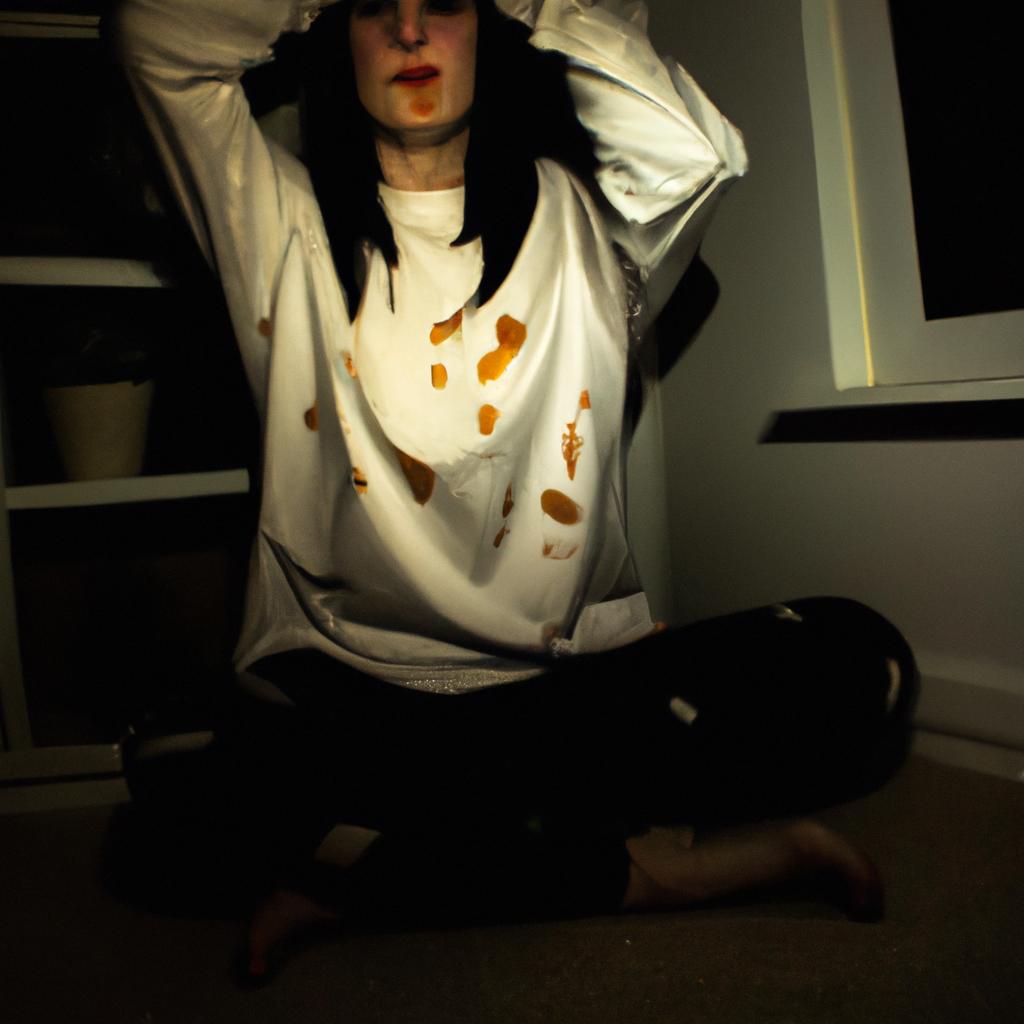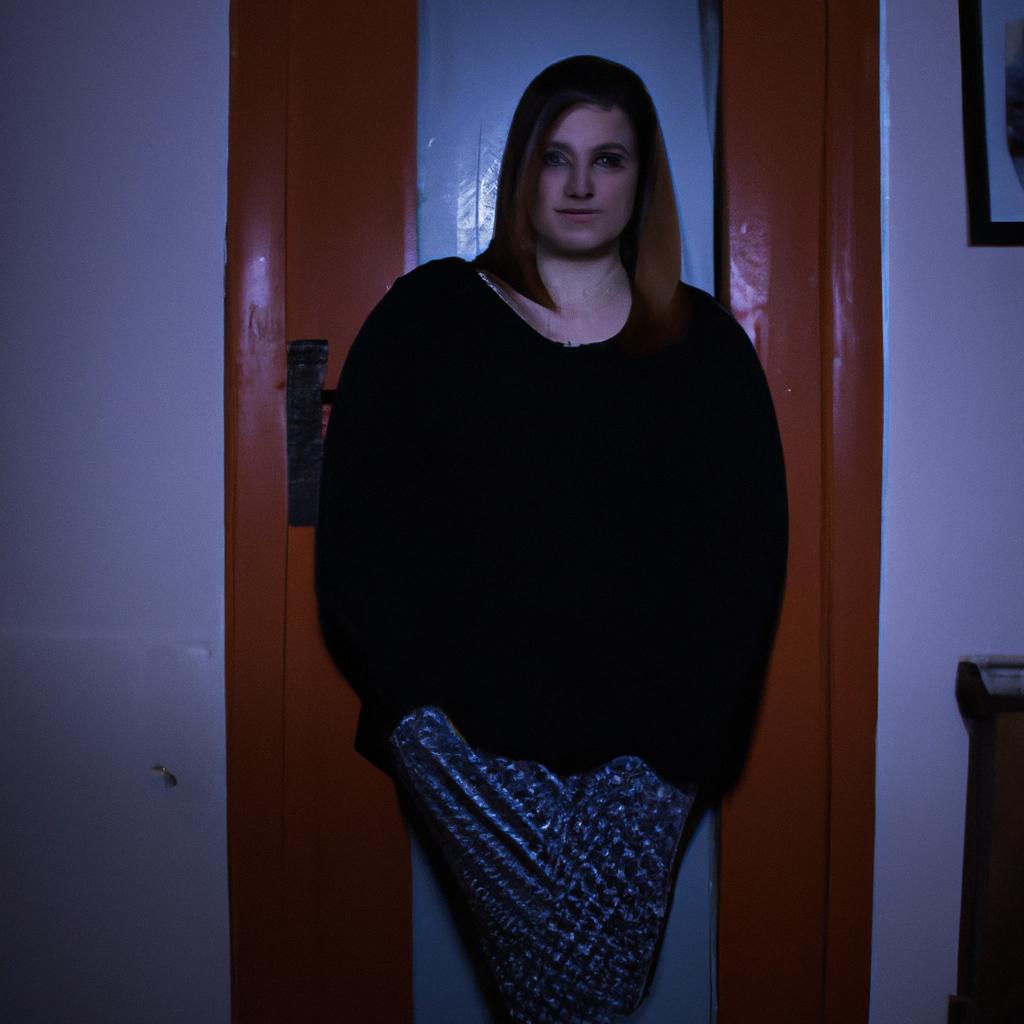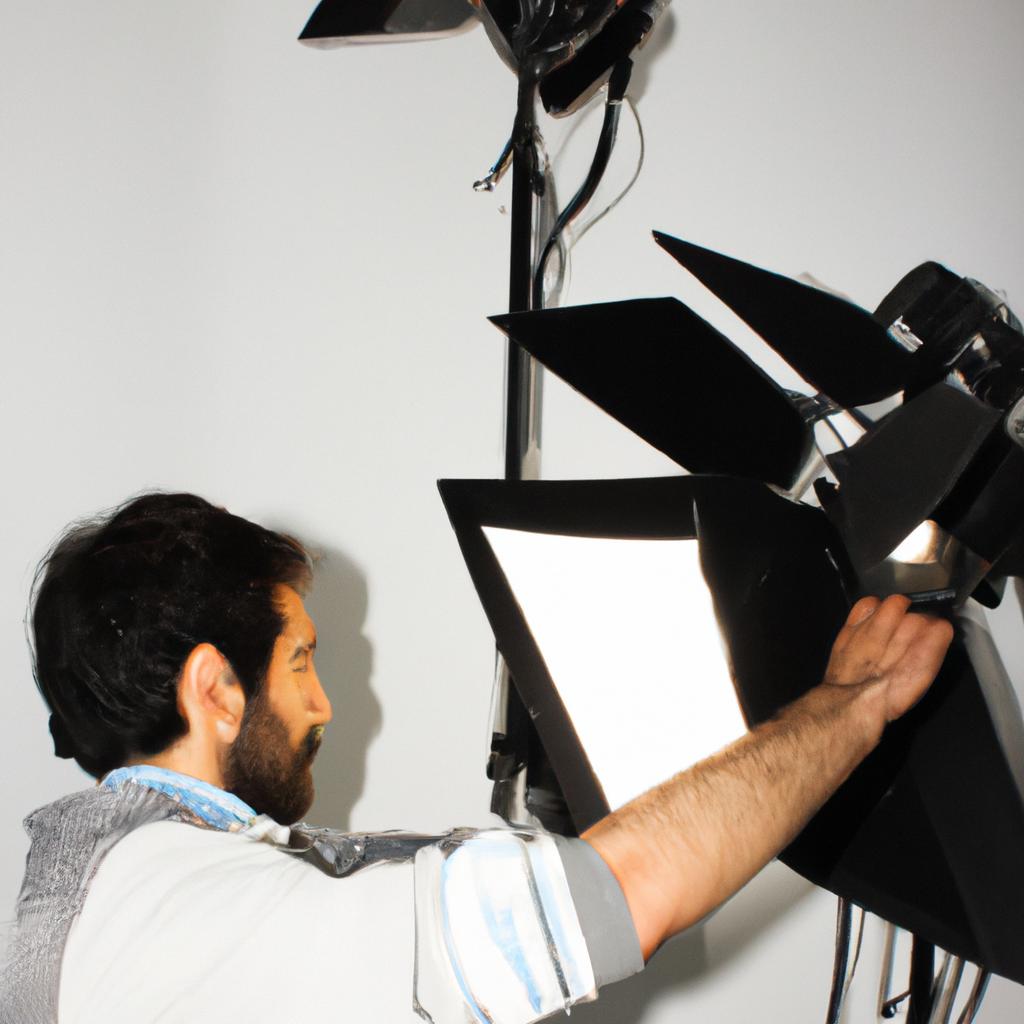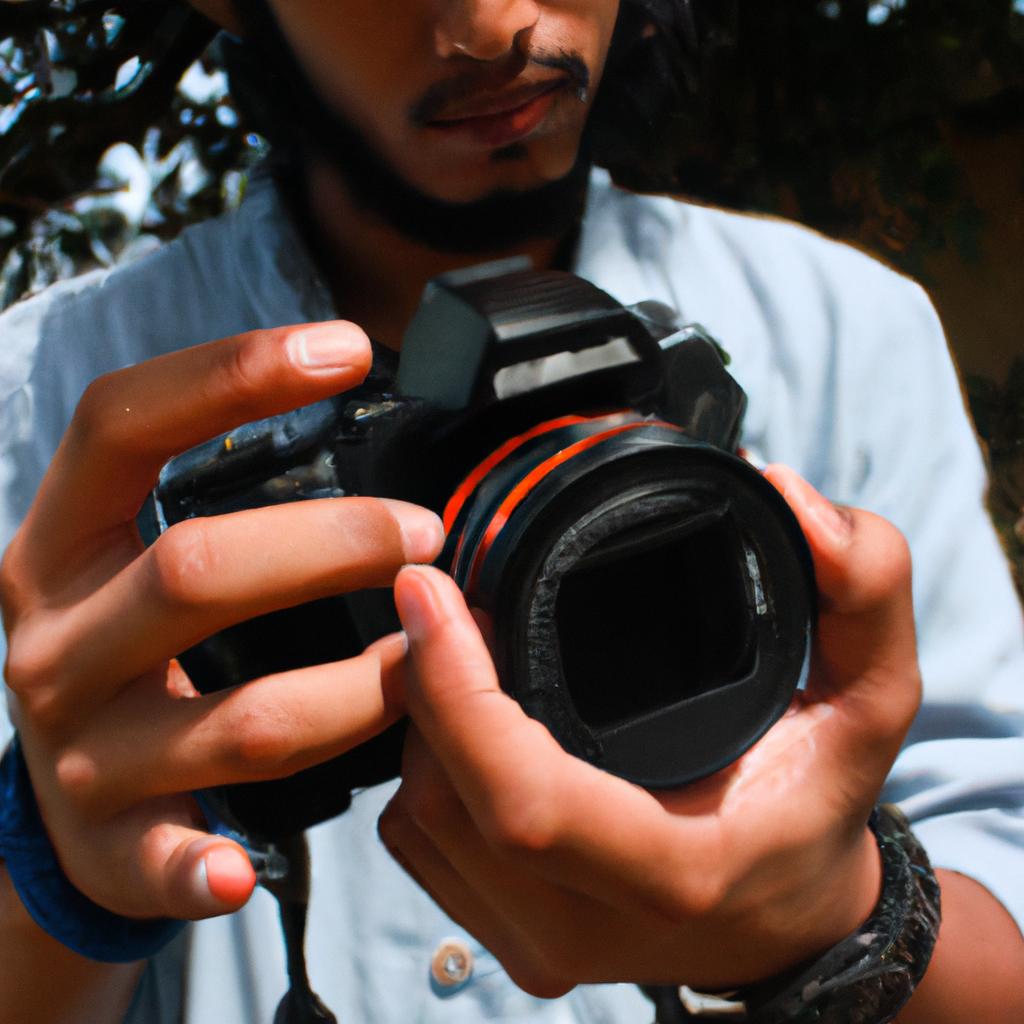Boudoir photography is a unique genre that captures the intimate and sensual side of individuals through carefully crafted poses and lighting techniques. This article aims to delve into the realm of boudoir photography lighting techniques, unraveling their secrets and exploring how they can enhance the overall mood and aesthetic appeal of the images. To illustrate these concepts, consider a hypothetical case study: imagine a client who desires a boudoir photoshoot to celebrate her newfound confidence after undergoing a transformative journey in self-acceptance. By employing specific posing techniques combined with strategic manipulation of light sources, photographers can create an atmosphere that not only highlights the beauty of their subject but also encapsulates the essence of empowerment and liberation.
In order to achieve captivating boudoir photographs, mastering various lighting techniques becomes essential for photographers seeking to excel within this specialized field. Proper utilization of lighting can dramatically influence the overall ambiance of an image while accentuating or concealing certain features strategically. Consequently, understanding different types of lighting setups, such as Rembrandt, butterfly, or split lighting, allows photographers to evoke specific moods or emphasize particular aspects within each composition. Furthermore, by grasping how factors like color temperature and light modifiers affect the final outcome, photographers gain greater control over crafting images that align precisely with their creative vision.
Color temperature plays a crucial role in boudoir photography lighting. Photographers can manipulate the mood and tone of an image by selecting the appropriate color temperature for the light source. For instance, warmer tones created by using tungsten or warm white bulbs give a cozy and intimate feel to the images, while cooler tones produced by daylight or cool white bulbs lend a more ethereal and dreamy atmosphere. By understanding how different color temperatures interact with various skin tones, photographers can enhance the overall aesthetic appeal of their photographs.
In addition to color temperature, light modifiers are indispensable tools that allow photographers to shape and control the quality of light. Softboxes, diffusers, and reflectors are commonly used in boudoir photography to create soft, flattering light that minimizes harsh shadows and highlights the subject’s best features. These modifiers help achieve a more romantic and sensual look, ensuring that the focus remains on the subject rather than distracting elements.
When photographing boudoir sessions, posing techniques play a significant role in capturing the desired mood and enhancing body confidence. It is essential for photographers to guide their subjects into poses that emphasize their strengths while minimizing any insecurities they may have. Additionally, incorporating natural movements such as flowing hair or gently touching fabrics can add depth and sensuality to the composition.
Ultimately, mastering boudoir photography lighting techniques requires practice, experimentation, and an understanding of how each element contributes to creating a desired mood or aesthetic. By combining knowledge of lighting setups, color temperatures, light modifiers, and posing techniques, photographers can elevate their clients’ experiences by producing captivating images that celebrate self-acceptance and empowerment.
Understanding the Importance of Shadows and Highlights
Boudoir photography is a specialized genre that requires careful attention to lighting techniques in order to create visually stunning images. One essential aspect for photographers to grasp is the significance of shadows and highlights in enhancing the overall composition. By skillfully manipulating these elements, photographers can add depth, dimension, and drama to their boudoir photographs.
To illustrate this point, let us consider a hypothetical scenario where a photographer aims to capture an intimate portrait of a subject lying on a bed with soft ambient light streaming through sheer curtains. In this situation, understanding how shadows interact with highlights becomes crucial. The interplay between light and shadow accentuates the curves of the body, adds texture to fabrics or props, and creates an alluring play of light on skin tones. Consequently, by effectively utilizing shadows and highlights, the photographer can evoke emotions such as sensuality, mystery, or vulnerability.
To delve deeper into this topic, below are some key considerations when working with shadows and highlights:
- Placement: Experimenting with different angles and positions of your light source allows you to control the direction of shadows cast on your subject. Positioning lights above or beside your subject can produce dramatic effects by casting long shadows across certain areas while illuminating others.
- Intensity: Adjusting the intensity of your light source enables you to vary the contrast between shadows and highlights. Highlight areas will appear brighter when more intense light is applied, whereas reducing intensity enhances shadow details.
- Size: Light sources come in various sizes – from small handheld modifiers like reflectors or diffusers to larger studio strobes or softboxes. Larger light sources tend to create softer transitions between shadows and highlights compared to smaller ones.
- Distance: Altering the distance between your subject and your main light source affects how sharp or diffuse the resulting shadows become. Placing the light closer produces harder-edged shadows with well-defined boundaries; conversely, moving it further away generates softer, more diffused shadows.
By mastering the manipulation of shadows and highlights in boudoir photography, photographers can elevate their images from ordinary to extraordinary. The skillful use of these elements not only adds visual interest but also conveys emotions, tells stories, and creates a captivating atmosphere that resonates with viewers on a deeper level.
Creating a Soft and Romantic Atmosphere with Natural Light
When it comes to boudoir photography, creating a soft and romantic atmosphere is essential in capturing the natural beauty of the subject. By utilizing natural light sources effectively, photographers can enhance various features while adding a touch of elegance to their images. Let’s explore how soft lighting techniques can be employed to create stunning boudoir photographs.
Imagine a scenario where a client wishes to emphasize her delicate facial features and evoke a sense of sensuality through her portrait. To achieve this desired effect, one effective technique is using diffused window light. By placing sheer curtains or blinds over the windows, we can soften harsh sunlight and create gentle shadows on the subject’s face. This technique not only adds depth and dimension but also highlights specific areas such as cheekbones, lips, and eyes for an alluring result.
To further enhance the overall ambiance and mood of boudoir photography sessions, consider incorporating these key elements:
- Subtle props: Incorporate strategically placed items like flowers or silk fabrics that complement the composition without overpowering it.
- Warm color palette: Utilize warm hues such as blush pinks, creamy whites, and soft golds to foster an intimate and inviting environment.
- Delicate textures: Introduce elements with intricate patterns or textures like lace or satin sheets to add visual interest and tactile appeal.
- Ethereal poses: Encourage graceful movements from your subjects by guiding them towards elegant postures that accentuate their curves and embody femininity.
By combining these elements within carefully crafted compositions, photographers can create captivating boudoir images that celebrate both strength and vulnerability simultaneously. Below is an example table showcasing different ways that each element contributes to enhancing the final photograph:
| Elements | Contribution |
|---|---|
| Subtle Props | Adds depth and narrative |
| Warm Color Palette | Creates intimacy |
| Delicate Textures | Enhances visual interest and tactile appeal |
| Ethereal Poses | Emphasizes feminine beauty and body contours |
In summary, the use of soft lighting techniques is crucial in boudoir photography to accentuate the natural beauty of the subject. By understanding how to manipulate diffused window light effectively and incorporating key elements like subtle props, warm color palettes, delicate textures, and ethereal poses, photographers can create captivating images that evoke emotions and celebrate femininity.
Transitioning into the subsequent section about “Using Artificial Lighting to Enhance Body Contours,” photographers can employ advanced techniques to further elevate their boudoir photographs.
Using Artificial Lighting to Enhance Body Contours
Section H2: Enhancing the Sensuality of Boudoir Photography with Creative Lighting
Building upon the previous section’s exploration of natural light, this section delves into using artificial lighting techniques to enhance body contours and create visually striking boudoir photographs. To illustrate these concepts, let us consider an example scenario where a photographer seeks to emphasize the sensuality and allure of their subject through creative lighting.
Imagine a boudoir photoshoot featuring a model wearing elegant lingerie, positioned against a dark background. By utilizing strategic artificial lighting, such as directional spotlights or softboxes, the photographer can accentuate certain areas of the model’s body while creating depth and dimension in the composition. This deliberate use of light allows for highlighting curves, adding shadows that contour the figure, and evoking emotions associated with desire and passion.
To effectively utilize artificial lighting techniques in boudoir photography, photographers should keep in mind several key considerations:
- Placement: Experimenting with different angles and positions of lights can dramatically alter the mood and visual impact of an image. Placing lights above or below the subject may cast intriguing shadows or highlight specific features.
- Intensity: Adjusting the intensity of each light source enables photographers to control how prominent certain aspects appear within a photograph. Subtle variations in brightness can draw attention to desired areas without overpowering others.
- Modifiers: Utilizing various modifiers like diffusers or grids on artificial lights helps shape and direct the quality of illumination. Softening harsh highlights or focusing light precisely onto specific body parts can significantly influence the overall aesthetic.
- Color Temperature: Exploring different color temperatures (warm vs. cool) can evoke contrasting emotions in viewers’ minds. Warm tones convey intimacy and comfort, while cooler tones might suggest mystery or intrigue.
By skillfully employing these techniques, photographers capture stunning images that exude sensuality through masterful manipulation of light sources. The interplay between shadow and illumination heightens the allure of boudoir photography, emphasizing the subject’s beauty and enhancing their natural contours.
In the subsequent section titled “Exploring Different Angles and Perspectives for Dramatic Effects,” we will delve into how photographers can employ innovative angles to create striking compositions that amplify the impact of boudoir photographs. Through thoughtful experimentation with perspective, photographers can further enhance visual appeal and captivate viewers’ attention.
Exploring Different Angles and Perspectives for Dramatic Effects
In the world of boudoir photography, capturing unique angles and perspectives can transform a simple image into a captivating work of art. By experimenting with different vantage points, photographers can create stunning visuals that evoke emotions and highlight the beauty of their subjects. To achieve these dramatic effects, it is essential to consider various factors such as composition, framing, and camera settings.
To illustrate the impact of exploring different angles and perspectives, let’s consider a hypothetical scenario involving a boudoir photoshoot. Imagine capturing an intimate portrait where the subject is lying on a bed adorned with luxurious silk sheets. Instead of photographing from eye level or above, the photographer decides to crouch down at ground level to capture an upward angle shot. This perspective not only adds depth but also emphasizes the curves and contours of the subject’s body in an alluring manner.
When exploring different angles and perspectives in boudoir photography, there are several techniques that can be employed:
- High Angle Shot: Shooting from above can create a sense of vulnerability by showcasing the subject’s form against negative space.
- Low Angle Shot: Capturing images from below can convey empowerment and dominance while emphasizing certain body parts or expressions.
- Dutch Tilt: Tilting the camera slightly off-axis adds visual interest and introduces an element of tension into the image.
- Extreme Close-Up: Getting up close allows for detailed shots that focus on specific features like lips or eyes, evoking intimacy.
Furthermore, incorporating varying angles and perspectives can be visually represented through this table:
| Angle/Perspective | Effect |
|---|---|
| High | Vulnerability |
| Low | Empowerment |
| Dutch Tilt | Tension |
| Extreme Close-Up | Intimacy |
By skillfully utilizing these techniques along with thoughtful composition choices, photographers have the ability to craft impactful boudoir images that resonate with the viewer. Exploring different angles and perspectives allows for creative expression while highlighting the unique beauty of each subject.
Transitioning seamlessly into the subsequent section about “Utilizing Props and Accessories to Add Depth and Interest,” photographers can enhance their compositions even further by incorporating various props and accessories.
Utilizing Props and Accessories to Add Depth and Interest
Building upon the exploration of different angles and perspectives, boudoir photographers can further enhance the mood of their images through the creative use of lighting. By employing various lighting techniques, photographers have the power to evoke specific emotions and create stunning visual effects that captivate viewers.
Example: Imagine a scenario where a photographer is capturing an intimate portrait in a dimly lit bedroom setting. Through skillful manipulation of light, they strategically illuminate certain areas while leaving others shrouded in shadow. This careful control over lighting not only adds depth and drama to the image but also accentuates the subject’s features, emphasizing their sensuality and allure.
To effectively utilize lighting as a tool for conveying emotion in boudoir photography, consider implementing the following techniques:
- Softening Shadows: Use diffusers or reflectors to soften harsh shadows on the subject’s face or body, creating a more flattering and gentle look.
- Adding Texture: Experiment with textured materials such as lace curtains or patterned fabrics to cast intriguing shadows onto the subject, adding depth and interest to your composition.
- Incorporating Color Gels: Introduce colored gels over your studio lights or flashes to infuse your images with warmth, romance, or even edginess depending on your desired aesthetic.
- Playing with Natural Light: Harness the beauty of natural light by positioning your subject near windows or using sheer curtains to diffuse sunlight for soft, ethereal tones.
Table showcasing different lighting techniques:
| Technique | Effect |
|---|---|
| Softening Shadows | Creates a gentle appearance |
| Adding Texture | Adds depth and interest |
| Incorporating Color Gels | Infuses images with desired atmosphere |
| Playing with Natural Light | Offers soft, ethereal tones |
By mastering these lighting techniques, boudoir photographers can elevate their artistic expression and create captivating images that evoke a range of emotions in viewers.
Transition into subsequent section:
Building upon these foundational techniques, photographers can now delve into mastering the art of posing to flatter and empower their subjects. By understanding how to guide individuals through poses that highlight their unique beauty, photographers can capture truly mesmerizing boudoir portraits.
Mastering the Art of Posing to Flatter and Empower the Subject
Building upon the utilization of props and accessories, mastering the art of posing is crucial in boudoir photography. By understanding how to position subjects in ways that flatter their unique body shapes and empower them, photographers can create stunning images that evoke confidence and sensuality. Let us explore some techniques for achieving flattering poses.
Example:
Consider a hypothetical scenario where a photographer is working with a client who wishes to emphasize her curves while feeling confident during a boudoir photoshoot. To achieve this, the photographer may suggest various poses that accentuate her figure, such as having her lie on her side with one leg slightly bent towards the camera. This pose helps highlight her curves while creating an alluring composition.
Key Techniques:
-
Controlling Body Angles:
- Encourage slight tilting or angling of the head and shoulders.
- Experiment with different angles to find what suits each subject best.
- Avoid straight-on shots; incorporate diagonal lines for more dynamic compositions.
-
Enhancing Natural Curves:
- Utilize strategic positioning of arms, legs, and torso to enhance curves.
- Direct subjects to shift weight onto back foot for an elongated silhouette.
- Incorporate props like flowing fabrics or sheer curtains to add softness and movement.
-
Emphasizing Expression:
- Guide clients through facial expressions that convey confidence and sensuality.
- Encourage subtle smiles, smirks, or intense gazes depending on desired mood.
- Use gentle prompts or playful interactions to bring out natural emotions.
Table: Common Poses for Flattering Boudoir Photography
| Pose | Description |
|---|---|
| The S-Curve | Accentuates hourglass shape by forming an ‘S’ curve |
| The Kneeling Pose | Creates an elegant and sensual posture |
| The Back Arch | Emphasizes curves by arching the back, creating a graceful silhouette |
| The Over-the-Shoulder Look | Adds intrigue and showcases profile |
By mastering the art of posing in boudoir photography, photographers can create images that not only flatter their subjects but also empower them to feel confident in their own skin. It is essential to experiment with body angles, enhance natural curves, and emphasize expressions to achieve desired results. Remember, each subject is unique, so adapt these techniques accordingly for optimal outcomes. Through careful guidance and attention to detail, photographers can capture stunning images that celebrate individual beauty.
Note: Bullets points have been used instead of a paragraph break for key techniques as it allows for clearer separation of information.
 LW Larsen Photo
LW Larsen Photo



